Pedro Javier Ortiz Suárez
ALMAnaCH, SU
Quality at a Glance: An Audit of Web-Crawled Multilingual Datasets
Mar 22, 2021
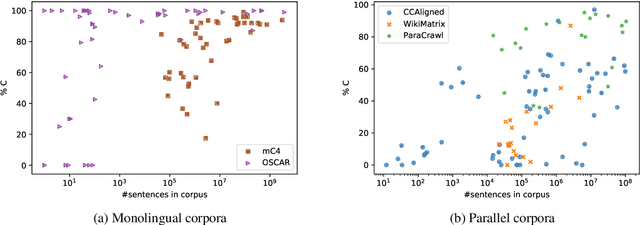
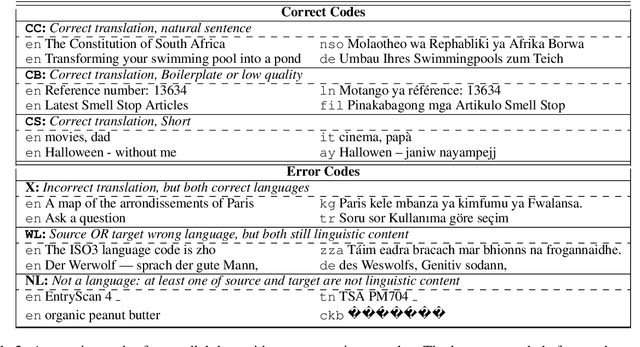
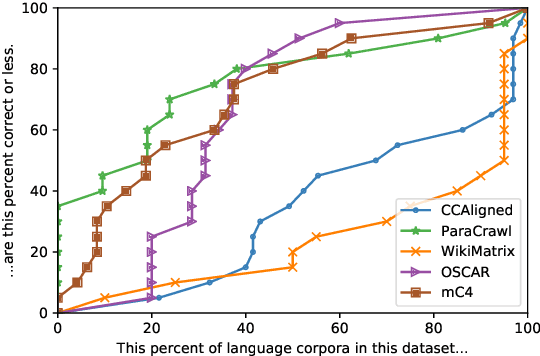
Abstract:With the success of large-scale pre-training and multilingual modeling in Natural Language Processing (NLP), recent years have seen a proliferation of large, web-mined text datasets covering hundreds of languages. However, to date there has been no systematic analysis of the quality of these publicly available datasets, or whether the datasets actually contain content in the languages they claim to represent. In this work, we manually audit the quality of 205 language-specific corpora released with five major public datasets (CCAligned, ParaCrawl, WikiMatrix, OSCAR, mC4), and audit the correctness of language codes in a sixth (JW300). We find that lower-resource corpora have systematic issues: at least 15 corpora are completely erroneous, and a significant fraction contains less than 50% sentences of acceptable quality. Similarly, we find 82 corpora that are mislabeled or use nonstandard/ambiguous language codes. We demonstrate that these issues are easy to detect even for non-speakers of the languages in question, and supplement the human judgements with automatic analyses. Inspired by our analysis, we recommend techniques to evaluate and improve multilingual corpora and discuss the risks that come with low-quality data releases.
A Monolingual Approach to Contextualized Word Embeddings for Mid-Resource Languages
Jun 18, 2020


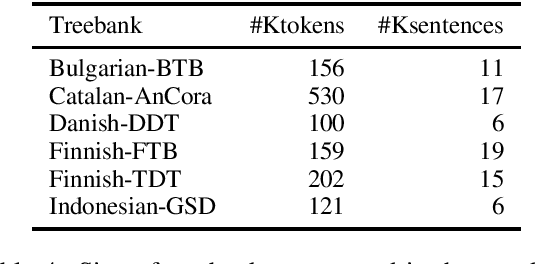
Abstract:We use the multilingual OSCAR corpus, extracted from Common Crawl via language classification, filtering and cleaning, to train monolingual contextualized word embeddings (ELMo) for five mid-resource languages. We then compare the performance of OSCAR-based and Wikipedia-based ELMo embeddings for these languages on the part-of-speech tagging and parsing tasks. We show that, despite the noise in the Common-Crawl-based OSCAR data, embeddings trained on OSCAR perform much better than monolingual embeddings trained on Wikipedia. They actually equal or improve the current state of the art in tagging and parsing for all five languages. In particular, they also improve over multilingual Wikipedia-based contextual embeddings (multilingual BERT), which almost always constitutes the previous state of the art, thereby showing that the benefit of a larger, more diverse corpus surpasses the cross-lingual benefit of multilingual embedding architectures.
Establishing a New State-of-the-Art for French Named Entity Recognition
May 27, 2020
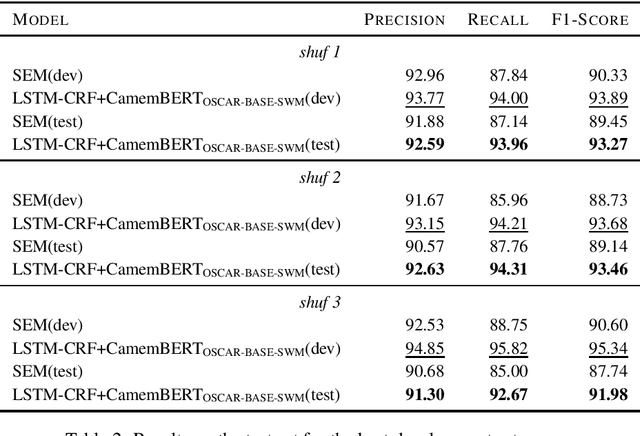
Abstract:The French TreeBank developed at the University Paris 7 is the main source of morphosyntactic and syntactic annotations for French. However, it does not include explicit information related to named entities, which are among the most useful information for several natural language processing tasks and applications. Moreover, no large-scale French corpus with named entity annotations contain referential information, which complement the type and the span of each mention with an indication of the entity it refers to. We have manually annotated the French TreeBank with such information, after an automatic pre-annotation step. We sketch the underlying annotation guidelines and we provide a few figures about the resulting annotations.
CamemBERT: a Tasty French Language Model
Nov 10, 2019



Abstract:Pretrained language models are now ubiquitous in Natural Language Processing. Despite their success, most available models have either been trained on English data or on the concatenation of data in multiple languages. This makes practical use of such models --in all languages except English-- very limited. Aiming to address this issue for French, we release CamemBERT, a French version of the Bi-directional Encoders for Transformers (BERT). We measure the performance of CamemBERT compared to multilingual models in multiple downstream tasks, namely part-of-speech tagging, dependency parsing, named-entity recognition, and natural language inference. CamemBERT improves the state of the art for most of the tasks considered. We release the pretrained model for CamemBERT hoping to foster research and downstream applications for French NLP.
 Add to Chrome
Add to Chrome Add to Firefox
Add to Firefox Add to Edge
Add to Edge